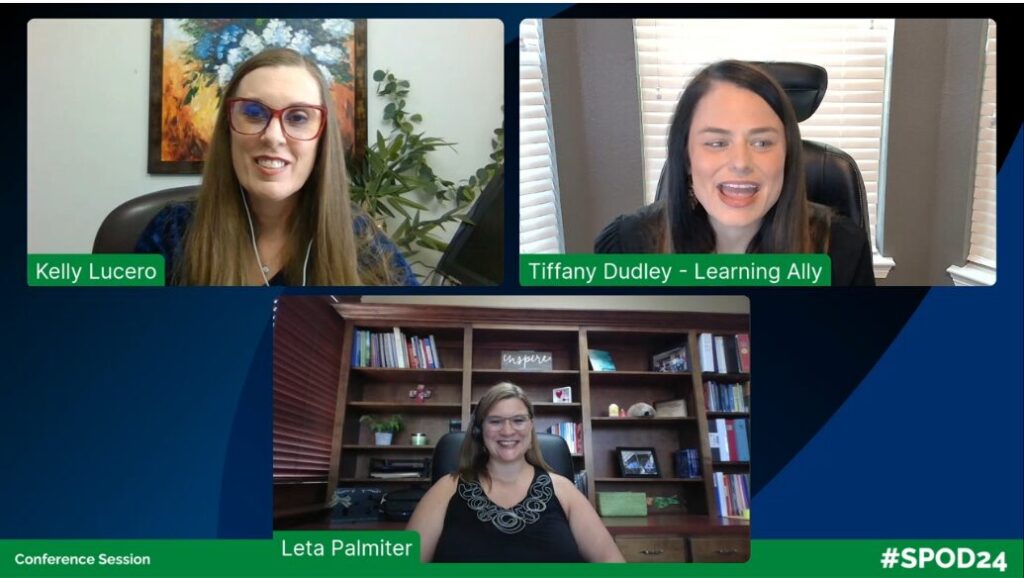Artificial intelligence (AI) isn’t replacing teachers—it’s supporting them in powerful new ways to personalize reading instruction and support every learner. That was the central message from Leta Palmiter and Kelly Lucero during their Spotlight on Dyslexia 2024 session, Empowering Reading Instruction with AI: Harnessing Technology for Individualized and Enhanced Learning.
Drawing on years of experience as dyslexia specialists and professional learning facilitators, Leta and Kelly helped educators understand what AI is, why it matters, and how it can make daily reading instruction more efficient and more responsive to student needs—including those with dyslexia.

What Is AI in Education? Understanding the Basics Behind Today’s Tools
Many of today’s AI-for-education tools are powered by large language models (LLMs). These systems are trained on massive collections of text and can assist educators with tasks such as drafting lessons, supporting student reading and writing, and simplifying everyday planning.
Educators already use versions of AI every day; spellcheck, speech-to-text, and predictive text are all early examples. Today’s tools simply build on these foundations and make them more accessible in the classroom.
Should Teachers Be Afraid of AI?
Feeling unsure about AI is normal—new technology often feels fast, unfamiliar, and overwhelming. In a 2024 EdWeek survey, two-thirds of K-12 educators reported they had not used AI-driven tools in their classrooms, 37% said they’d never used them and have no plans to start, while 29% planned to adopt them soon.
But the landscape shifted quickly. A 2025 EdWeek article found that 9 in 10 educators say AI has already changed the job of teaching at least “a little”, and 42% said it has changed the profession “a fair amount” or “a lot”.
Leta and Kelly emphasized an essential point:
“Educators are not replaceable. AI is here to support teachers, not replace them.”
AI can enhance—not replace—educator expertise by helping teachers:
- Save time on planning, differentiating, and documentation
- Create materials tailored to student needs
- Improve accessible learning for students with dyslexia and other reading differences
- Focus instructional time on human connection and expert decision-making
With thoughtful use, AI becomes another tool in the teacher’s toolbox—not a threat to the profession.
How AI Saves Teachers Time: Tools That Streamline Planning and Differentiation
During the session, Leta and Kelly highlighted several AI tools that streamline planning, differentiation, and documentation. Popular options include:
- Magic School AI: Supports IEP language, decodable text creation, choice boards, and differentiation
- Curipod: Creates interactive lessons with polls, drawing prompts, and literacy activities
- Diffit: Levels text, generates comprehension questions, vocabulary lists, and scaffolded reading passages
- Formative AI: Converts PDFs into editable documents and auto-graded quizzes
- Brisk Teaching: Offers plagiarism checks, reading-level adjustments, and student-friendly summaries
- ChatGPT & Microsoft Copilot: For drafting emails, scaffolding content, generating decodables, and more—Copilot adds linked sources for expanded learning
AI Supports for Students with Dyslexia and Reading Difficulties
AI empowers students with dyslexia by improving access, reducing frustration, and supporting independence. Helpful AI-powered literacy tools include:
- Reading access: screen readers, text-to-speech, smart pens
- Writing support: grammar tools, spelling assistance, word prediction, and writing scaffolds
- Organization: reminders, digital planners, and task management apps
- Practice tools: Exercise, Whole Phonics, and emerging AI-powered decodable readers
Leta noted that emerging tools can analyze a child’s oral reading for patterns (e.g., blend errors, missing syllables), providing teachers with time-saving insights into reading behaviors.
How To Start Using AI in Literacy Instruction
Leta and Kelly recommended two simple steps to begin using AI for reading instruction:
1. Start With One AI Tool.
Choose one platform and use it consistently for planning or differentiation before adding more.
2. Develop a Classroom AI Use Policy.
Teach students to use AI responsibly by focusing on:
- Brainstorming and summarizing, not copying
- Rewriting AI-generated content in their own words
- Comparing AI outputs to their own work to strengthen critical thinking
AI should support student learning—not replace it.
The Future of AI in Reading Instruction
AI in education is rapidly evolving. Teachers can expect advancements in:
- More personalized reading practice
- Real-time feedback on oral reading and fluency
- Automated creation of decodable texts and reading passages
- Enhanced accessibility for students with learning differences
- Smarter assistive technology for dyslexia
As Leta reminded educators:
“We are neurocognitive engineers—we change brains every day.”
AI doesn’t replace teacher expertise—it amplifies it.
Professional Learning: Where to Learn More About AI and Dyslexia Support
Want to deepen your understanding of AI tools and their impact on literacy instruction?
Register for Learning Ally’s upcoming webinars, including:
🗓️ The Intersection of AI and LD: Dyslexia & Education in the Age of AI
Check back for upcoming sessions exploring how educators can strengthen literacy instruction and support every learner.